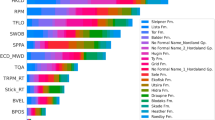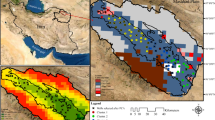Abstract
Accurate and reliable prediction of groundwater level is essential for water resource development and management. This study was carried out to test the validity of three nonlinear time-series intelligence models, artificial neural networks (ANN), support vector machines (SVM) and adaptive neuro fuzzy inference system (ANFIS) in the prediction of the groundwater level when taking the interaction between surface water and groundwater into consideration. These three models were developed and applied for two wells near Lake Okeechobee in Florida, United States. 10 years data-sets including hydrological parameters such as precipitation (P), temperature (T), past groundwater level (G) and lake level (L) were used as input data to forecast groundwater level. Five quantitative standard statistical performance evaluation measures, correlation coefficient (R), normalized mean square error (NMSE), root mean squared error (RMSE), Nash-Sutcliffe efficiency coefficient (NS) and Akaike information criteria (AIC), were employed to evaluate the performances of these models. The conclusions achieved from this research would be beneficial to the water resources management, it proved the necessity and effect of considering the surface water-groundwater interaction in the prediction of groundwater level. These three models were proved applicable to the prediction of groundwater level one, two and three months ahead for the area that is close to the surface water, for example, the lake area. The models using P, T, G and L achieved better prediction result than that using P, T and G only. At the same time, results from ANFIS and SVM models were more accurate than that from ANN model.










Similar content being viewed by others
References
Afan HA, El-Shafie A, Yaseen ZM, Hameed MM, Wan Mohtar WHM, Hussain A (2015) ANN based sediment prediction model utilizing different input scenarios. Water Resour Manag 29:1231–1245
Akaike H (1974) A new look at the statistical model identification. IEEE Trans Autom Control AC-19:716–723
Ala-aho P, Rossi PM, Isokangas E, Kløve B (2015) Fully integrated surface–subsurface flow modelling of groundwater–lake interaction in an esker aquifer: model verification with stable isotopes and airborne thermal imaging. J Hydrol 522:391–406
ASCE (2000a) Artificial neural networks in hydrology. I: Preliminary concepts. J Hydrol Eng 5:115–123
ASCE (2000b) Artificial neural networks in hydrology. II: Hydrologic Applications Journal of Hydrologic Engineering 5:124–137
Awan JA, Bae D-H (2014) Improving ANFIS based model for long-term dam inflow prediction by incorporating monthly rainfall forecasts. Water Resour Manag 28:1185–1199
Ch S, Anand N, Panigrahi BK, Mathur S (2013) Streamflow forecasting by SVM with quantum behaved particle swarm optimization. Neurocomputing 101:18–23
Chang CC, Lin CJ (2011) LIBSVM: a library for support vector machines. ACM Trans Intell Syst Technol 2:1–27
Cho S et al. (2014) Factors affecting algal blooms in a man-made lake and prediction using an artificial neural network. Measurement 53:224–233
Çimen M, Kisi O (2009) Comparison of two different data-driven techniques in modeling lake level fluctuations in Turkey. J Hydrol 378:253–262
Emamgholizadeh S, Moslemi K, Karami G (2014) Prediction the groundwater level of bastam plain (Iran) by artificial neural network (ANN) and adaptive neuro-fuzzy inference system (ANFIS). Water Resour Manag 28:5433–5446
Goyal MK, Bharti B, Quilty J, Adamowski J, Pandey A (2014) Modeling of daily pan evaporation in sub tropical climates using ANN, LS-SVR, fuzzy logic, and ANFIS. Expert Syst Appl 41:5267–5276
Güldal V, Tongal H (2010) Comparison of recurrent neural network, adaptive neuro-fuzzy inference system and stochastic models in eğirdir lake level forecasting. Water Resour Manag 24:105–128
Haykin S (1999) Neural networks: a comprehensive foundation. Prentice Hall
He Z, Wen X, Liu H, Du J (2014) A comparative study of artificial neural network, adaptive neuro fuzzy inference system and support vector machine for forecasting river flow in the semiarid mountain region. J Hydrol 509:379–386
Hipni A, El-shafie A, Najah A, Karim OA, Hussain A, Mukhlisin M (2013) Daily forecasting of dam water levels: comparing a support vector machine (SVM) model with adaptive neuro fuzzy inference system (ANFIS). Water Resour Manag 27:3803–3823
Jang JSR (1993) ANFIS : adaptive Ne twork based fuzzy inference system. IEEE Trans Syst, Man, Cybern 23:665–685
Jang JSR, Sun CT, Mizutani E (1997) Neuro-fuzzy and soft computing: a computational approach to learning and machine intelligence. Prentice Hall
Latt ZZ, Wittenberg H, Urban B (2014) Clustering hydrological homogeneous regions and neural network based index flood estimation for ungauged catchments: an example of the chindwin river in Myanmar. Water Resour Manag 29:913–928
Lin J-Y, Cheng C-T, Chau K-W (2006) Using support vector machines for long-term discharge prediction. Hydrol Sci J 51:599–612
Martinez JL, Raiber M, Cox ME (2015) Assessment of groundwater-surface water interaction using long-term hydrochemical data and isotope hydrology: headwaters of the condamine river, southeast Queensland, Australia. Sci Total Environ 536:499–516
Matlab (2013) version 8.1.0 Natick, Massachusetts: The Math Works Inc. (http://www.mathworks.com)
Moghaddamnia A, Ghafari Gousheh M, Piri J, Amin S, Han D (2009) Evaporation estimation using artificial neural networks and adaptive neuro-fuzzy inference system techniques. Adv Water Resour 32:88–97
Nastos PT, Paliatsos AG, Koukouletsos KV, Larissi IK, Moustris KP (2014) Artificial neural networks modeling for forecasting the maximum daily total precipitation at athens, Greece. Atmos Res 144:141–150
Noori R, Karbassi AR, Moghaddamnia A, Han D, Zokaei-Ashtiani MH, Farokhnia A, Gousheh MG (2011) Assessment of input variables determination on the SVM model performance using PCA, gamma test, and forward selection techniques for monthly stream flow prediction. J Hydrol 401:177–189
O’Connor MT, Moffett KB (2015) Groundwater dynamics and surface water–groundwater interactions in a prograding delta island, Louisiana, USA. J Hydrol 524:15–29
Platt JC (1999) Fast training of support vector machines using sequential minimal optimization. In: Christopher JCB, Alexander JS (eds) Bernhard S, lkopf. MIT Press, Advances in kernel methods, pp. 185–208
Samarasinghe S (2006) Neural networks for applied sciences and engineering. Auerbach Publications
Scholkopf B, Smola AJ (2002) Learning with kernels: support vector machines, regularization, optimization, and beyond. MIT Press
Shevade SK, Keerthi SS, Bhattacharyya C, Murthy KRK (2000) Improvements to the SMO algorithm for SVM regression. IEEE Trans Neural Netw 11:1188–1193
Shiri J, Kişi Ö (2011) Comparison of genetic programming with neuro-fuzzy systems for predicting short-term water table depth fluctuations. Comput Geosci 37:1692–1701
Shirmohammadi B, Vafakhah M, Moosavi V, Moghaddamnia A (2013) Application of several data-driven techniques for predicting groundwater level. Water Resour Manag 27:419–432
Shu C, Ouarda TBMJ (2008) Regional flood frequency analysis at ungauged sites using the adaptive neuro-fuzzy inference system. J Hydrol 349:31–43
Sreekanth PD, Sreedevi PD, Ahmed S, Geethanjali N (2010) Comparison of FFNN and ANFIS models for estimating groundwater level. Environ Earth Sci 62:1301–1310
Sun S, Xu X (2011) Variational inference for infinite mixtures of gaussian processes with applications to traffic flow prediction. IEEE Trans Intell Transp Syst 12:466–475
Sun S, Zhang C, Yu G (2006) A bayesian network approach to traffic flow forecasting. IEEE Trans Intell Transp Syst 7:124–132
Tabari H, Kisi O, Ezani A, Hosseinzadeh Talaee P (2012) SVM, ANFIS, regression and climate based models for reference evapotranspiration modeling using limited climatic data in a semi-arid highland environment. J Hydrol 444-445:78–89
Talebizadeh M, Moridnejad A (2011) Uncertainty analysis for the forecast of lake level fluctuations using ensembles of ANN and ANFIS models. Expert Syst Appl 38:4126–4135
Vapnik VN (1995) The nature of statistical learning theory. Springer-Verlag New York, Inc.
Vapnik VN (1998) Statistical learning theory. Wiley
Verma AK, Singh TN (2013) Prediction of water quality from simple field parameters. Environ Earth Sci 69:821–829
Vernieuwe H, Georgieva O, De Baets B, Pauwels VRN, Verhoest NEC, De Troch FP (2005) Comparison of data-driven takagi–sugeno models of rainfall–discharge dynamics. J Hydrol 302:173–186
Wen X, Si J, He Z, Wu J, Shao H, Yu H (2015) Support-vector-machine-based models for modeling daily reference evapotranspiration with limited climatic data in extreme arid regions. Water Resour Manag 29:3195–3209
Yoon H, Jun SC, Hyun Y, Bae GO, Lee KK (2011) A comparative study of artificial neural networks and support vector machines for predicting groundwater levels in a coastal aquifer. J Hydrol 396:128–138
Acknowledgments
This study was supported by National Key Technology Research and Development Program (2011BAC12B00), Basic Research Foundation of Beijing University of Technology and China Scholarship Council. The authors gratefully acknowledge the helpful and insightful comments of the editor and anonymous reviewers.
Author information
Authors and Affiliations
Corresponding authors
Rights and permissions
About this article
Cite this article
Gong, Y., Zhang, Y., Lan, S. et al. A Comparative Study of Artificial Neural Networks, Support Vector Machines and Adaptive Neuro Fuzzy Inference System for Forecasting Groundwater Levels near Lake Okeechobee, Florida. Water Resour Manage 30, 375–391 (2016). https://doi.org/10.1007/s11269-015-1167-8
Received:
Accepted:
Published:
Issue Date:
DOI: https://doi.org/10.1007/s11269-015-1167-8




